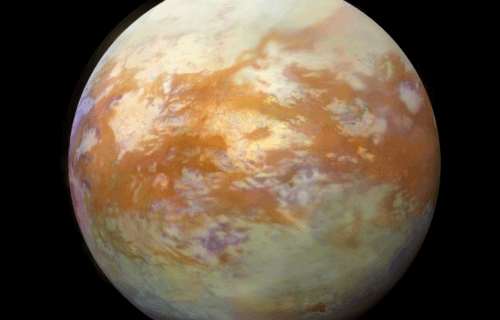GREENBELT, Md. — When people think about the possibility of life far beyond the stars, they probably think about a planet. NASA researchers say not only could life be much closer to home, but it may be sitting on a moon. Astronomers have found a molecule in the atmosphere of Titan, Saturn’s largest moon, that has never been discovered inside an atmosphere before. Making the find more exciting, NASA says this molecule could be a building block for life on the distant moon.
Using a radio telescope observatory in northern Chile, researchers discovered cyclopropenylidene (C3H2) in the dense clouds of Titan. Along with being difficult to pronounce, NASA says few chemists have probably even heard of this molecule.
C3H2, which consists of carbon and hydrogen, has only been found in gas clouds floating between star systems until now. Typically, cyclopropenylidene reacts with other molecules it comes into contact with. This is why the cold emptiness of space is one of the only places the molecules have been detected outside of Titan.
“When I realized I was looking at cyclopropenylidene, my first thought was, ‘Well, this is really unexpected,'” says Conor Nixon from NASA’s Goddard Space Flight Center in a media release.
Signs of life on Titan?
Titan may be one of 62 moons swirling around Saturn, but astronomers say this satellite is very unique. While our moon is barren, Titan has a thick atmosphere which is four times denser than Earth’s. It also has clouds, rain, lakes, rivers, and a salty subterranean ocean.
Researchers say the discovery of this simple carbon-based molecule just adds to the possibility the moon has or had some form of life on it. The study finds C3H2 may be a building block for more complex compounds that either feed or form organisms.
“Titan is unique in our solar system,” Nixon adds. “It has proved to be a treasure trove of new molecules.”
The cyclopropenylidene detected comes mostly from Titan’s upper atmosphere; which NASA believes is why it hasn’t interacted with other molecules and turned into something else. Most of the moon’s atmosphere is made of nitrogen, just like Earth.
“We’re trying to figure out if Titan is habitable,” says Rosaly Lopes, a senior research scientist and Titan expert at NASA’s Jet Propulsion Laboratory (JPL). “So we want to know what compounds from the atmosphere get to the surface, and then, whether that material can get through the ice crust to the ocean below, because we think the ocean is where the habitable conditions are.”
What makes the molecule so important?
Researchers say cyclopropenylidene is one of only two “cyclic” (closed-loop) molecules in Titan’s atmosphere that have been discovered. While it’s not known to be part of biological reactions, closed-loop molecules are vital because they form the backbone of DNA and RNA.
“It’s a very weird little molecule, so it’s not going be the kind you learn about in high school chemistry or even undergraduate chemistry,” explains JPL planetary scientist Michael Malaska. “Down here on Earth, it’s not going be something you’re going to encounter. Every little piece and part you can discover can help you put together the huge puzzle of all the things going on there.”
The study appears in the Astronomical Journal.
